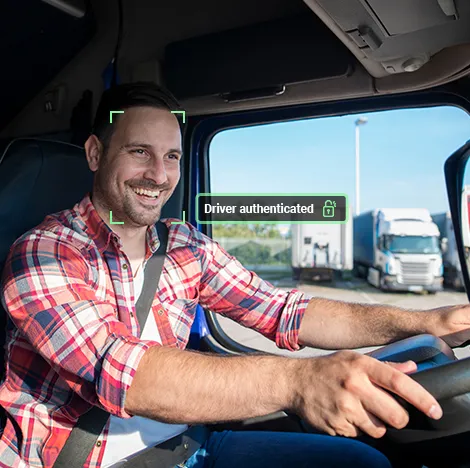Truck driver monitoring — how it works, and why it’s important

Truck driver monitoring systems are used primarily to reduce accidents caused by fatigue, drowsiness, and distractions. But they can also be used to improve other aspects. In this article, you’ll learn how truck driver monitoring works, and why you should implement it as soon as possible.
The bigger the vehicle, the bigger the risks
Heavy commercial vehicles, such as semi-trucks, tractor-trailers, or tanker trucks, pose significant risks to public safety. Due to the sheer size and weight of these vehicles, even a minor error by the driver can have serious consequences. These are some of the most significant risks, that are especially important to address in the case of truck drivers:
Risk #1: Distractions
The more time drivers spend on the road, the more likely they are to be distracted by other activities. Another study from the NHTSA found that 3,142 people died in distraction-affected crashes in 2020.
Behaviors like mobile phone use or eating while driving are the most common causes of such crashes. As they are covering longer distances than average drivers, truck drivers will most likely face an even greater urge to check their phones or grab a bite to eat while steering the wheel. However, doing so is an even greater hazard when operating a large vehicle.
Risk #2: Drowsiness
As truck drivers spend more time on the road than the average driver, they are naturally more prone to fatigue or drowsiness. According to research, driving drowsy even has similar effects on the human body as driving drunk. And the National Highway Traffic Safety Administration (NHTSA) reported there were 633 deaths from drowsy-driving-related crashes in 2020.
Moreover, the AAA Foundation found that drowsy driving was involved in over 10% of all crashes reported to the police. They concluded this phenomenon is severely under-reported because it’s so hard to identify after a crash has already happened.

Truck driver monitoring will become obligatory in 2024
As a result, there are strict safety requirements in place to ensure heavy commercial vehicles are operated safely and responsibly. One of the latest such requirements is the Advanced Driver Distraction Warning (ADDW) mandate. As part of the European General Safety Regulation’s DDR (Driver Distraction and Drowsiness Recognition) safety measure, it aims to reduce road accidents and injuries caused by driver distraction.
The ADDW mandate requires vehicle manufacturers to implement a system that monitors drivers in real-time, and warns them if they get distracted while steering the wheel.
Manufacturers of heavy commercial vehicles must implement an ADDW system in all new vehicles by July 2024. They need to ensure their vehicles are compliant, as failure to do so can result in fines and other penalties.
How a truck driver monitoring system works
Overall, driver monitoring technologies use artificial intelligence (AI) to analyze the driver’s behavior, looking for signs of fatigue, distraction, or any sort of visual impairment. If the AI system detects any type of dangerous behavior by the driver, it triggers an alert, such as a light on the instrument panel or a warning sound. It can also activate safety functions automatically, like slowing down the vehicle.
Similar to other examples of AI adoption in cars, truck driver monitoring also relies on face-related technologies. These include face tracking, head tracking, and eye tracking. And they are possible through the use of cameras placed in the driver’s cabin.
Let’s use the example of FaceTrack, a software solution developed by Visage Technologies, to describe the most important features of a truck driver monitoring system:
- Real-time head and face tracking: Using advanced computer vision algorithms, the system detects and tracks the driver’s face in real time. Changes in the driver’s head position, such as tilting or nodding, can indicate early signs of fatigue or distraction.
- Eye tracking: FaceTrack can also track the movements and gaze of the driver’s eyes. Combined with head tracking, this can be used to determine the driver’s viewing direction and attention level. For example, if a driver looks away from the road for too long, or closes their eyes, the system will automatically recognize this as a distraction. It can be configured to warn the driver when that happens, bringing their attention back to the road by sounding an audio alert or performing some other action.
- Customization: FaceTrack can be customized to meet your specific needs. You can integrate it into an existing solution, or build a custom one around it. With 20+ years of experience in computer vision, our R&D team can help you every step of the way — from the initial integration to the development of new features or entire solutions.
Other technologies that can be used for monitoring drivers
Besides tracking the movements and position of the head, face, or eyes, there are other AI technologies that can not only address other risks but enhance the whole driving experience as well.
Emotion tracking
Emotions can be a very significant factor on the road. Driving while angry, sad, crying, or emotionally agitated, can increase the risk of a crash nearly tenfold, according to a 2016 study by the Virginia Tech Transportation Institute.

In this case, software like FaceAnalysis can be especially helpful. By analyzing a person’s face, it categorizes their emotions into one of the basic types: happiness, sadness, anger, fear, surprise, disgust, or a neutral feeling. In a driving situation, you can configure the system to suggest a stop if it detects negative emotions on the driver’s face, like anger. Alternatively, it can automatically reduce the vehicle’s speed, or suggest a different route that’s less crowded, and consequently less likely to agitate the driver further.
➥ Learn more about emotion recognition technology, its use cases and main advantages in this article.
Face recognition
There has been a surge in truck cargo thefts during the COVID-19 pandemic in 2020, as reported by CargoNet. Such events can not only result in direct losses of revenue but also potentially erode trust in a trucking company.
In these cases, it would be wise to upgrade the vehicle’s security. One way of doing that is by implementing real-time face recognition. You can then configure the truck driver monitoring system to unlock the vehicle only after recognizing the face of an authorized driver.
➥ Learn more about the benefits of face recognition technology in this article.

Besides security, this type of technology can also be used to remember the driver’s preferences and automatically restore them.
For instance, it can adjust the mirrors’ angles, the seat, play the driver’s preferred music, and more. This is very useful when a company has multiple drivers for the same vehicle in different shifts or route stages.
Implementing truck driver monitoring is both urgent and essential
To sum up the main points covered above:
- Truck driver monitoring is a critical technology for improving public safety, as well as the efficiency of transport.
- Vehicle manufacturers and their partners need to start implementing it today to meet regulatory demands.
- Face tracking, head tracking, and eye tracking are all crucial to truck driver monitoring systems
- While with emotion tracking and face recognition, you can improve security, and other aspects, as well.
Visage Technologies is a leading provider of AI solutions used for truck driver monitoring. If you, too, want to implement these top-notch solutions, we encourage you to contact us. Our team will be happy to answer any questions, and help make your vehicles safer for drivers and pedestrians everywhere.
Make your vehicles safer
Contact us today to find out how our computer vision solutions can help your business and make your vehicels safer for everyone.

